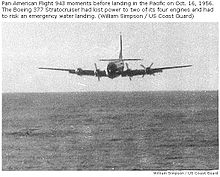Pan Am Flight 6

Pan Am Flight 6 ditching in the Pacific Ocean, photographed from US Coast Guard Cutter Pontchartrain
|
|
| Accident summary | |
|---|---|
| Date | October 16, 1956 |
| Summary | Engine failure, ditching at sea |
| Site |
Pacific Ocean Northeast of Hawaii 30°01.5′N 140°09′W / 30.0250°N 140.150°WCoordinates: 30°01.5′N 140°09′W / 30.0250°N 140.150°W |
| Passengers | 24 |
| Crew | 7 |
| Fatalities | 0 human, 44 cases of live canaries |
| Survivors | 31 (all) |
| Aircraft type | |
| Aircraft name | Clipper Sovereign Of The Skies |
| Operator | Pan American World Airways |
| Registration | N90943 |
Pan Am Flight 6 (registration N90943, and sometimes erroneously called Flight 943) was an around-the-world airline flight that ditched in the Pacific Ocean on October 16, 1956, after two of its four engines failed. Flight 6 left Philadelphia as a DC-6B and flew westward on a planned multi-stop trip. It stopped at San Francisco International Airport, then flew onward to Honolulu. On the evening of October 15, 1956, the flight left Honolulu on a named Clipper Sovereign Of The Skies (Pan Am fleet number 943, registered N90943). The accident was the basis for the 1958 film Crash Landing.
The aircraft took off from Honolulu, Territory of Hawaii, at 8:26 p.m. HST on the flight's last leg to San Francisco. After passing the point of equal time, the flight received permission to climb to an altitude of 21,000 ft (6,400 m). When that altitude was reached, the No. 1 engine began to overspeed as power was reduced. The First Officer, who was flying the plane, immediately slowed the plane by further reducing power and by extending the flaps, and an attempt was made to feather the propeller. The propeller would not feather and the engine continued to turn at excessive RPM. The captain decided to cut off the oil supply to the engine. Eventually, the RPM declined and the engine seized. The propeller continued to windmill in the air stream, causing excessive drag that increased the fuel consumption. As a result, the plane was forced to fly much more slowly, below 150 knots (280 km/h), and lost altitude at the rate of 1,000 feet per minute (5.1 m/s). Climb power was set on the remaining three engines to slow the rate of descent. The No. 4 engine then began to fail and soon was producing only partial power at full throttle. At 2:45 a.m. the No. 4 engine began to backfire, forcing the crew to shut it down and feather the propeller.
...
Wikipedia
